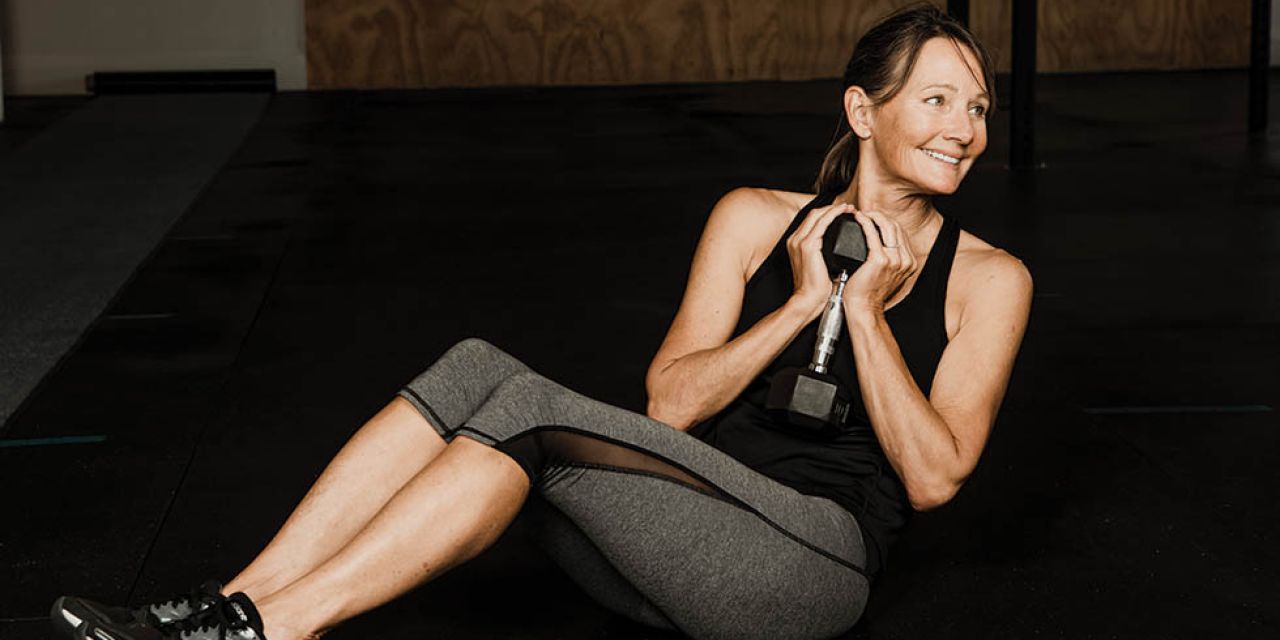Core twist
Ready to Rip
by Bruce Young, CrossFit Level 1 Certified, CanFit Certified Children’s Coach
photography by Clay Dolan
Ski season is nearly upon us, and with proper preparation now, you can prevent injuries and ensure that when the snow falls, you’re as ready as a freshly tuned pair of skis.
*Before beginning any new exercise program, consult with a healthcare professional to ensure the activities are appropriate for your individual health and fitness level.
The leaves have turned on the Escarpment, the paddleboards and bikes have been put away, and your thoughts are starting to turn to winter sports. Here are some simple exercises to help improve your cardiovascular endurance, build strength, and enhance core stability to ensure you’re in peak condition when the snow starts falling.
Cardiovascular Conditioning
Skiing puts high demands on your cardiovascular system for relatively short bursts of energy. To prepare for this, focus on increasing your heart and lung capacity. Two effective methods are interval training and Zone 2 training.
Interval training mimics the bursts of energy you use during a ski run. I recommend that my athletes perform high-energy output for 3 minutes, followed by rest periods of 3 minutes. This allows your heart rate to return to a resting state. You can achieve this using a rower, stationary bike, treadmill, or by running outside.
Another way to improve your cardiovascular conditioning is through Zone 2 training. Cardiovascular conditioning is divided into 5 zones, from Zone 1 (resting) to Zone 5 (only sustainable for short periods). Zone 2 allows for much longer sessions. To calculate your Zone 2 heart rate, subtract your age from 180. Another way to estimate Zone 2 is that you should be able to carry on a conversation while exercising.

Wall sit

Air squats
Wall sits are an excellent introduction to the squat family, focusing mainly on developing quadriceps strength. This exercise closely mimics the “burning quads” sensation you experience while skiing.
To perform a wall sit:
1. Stand with your back against a flat wall.
2. Walk your feet out about 2 feet in front of you, feet spread about 6 inches apart.
3. Slide your back down the wall, bending your knees until they are at a 90-degree angle.
4. Hold this seated position for 20-60 seconds. For an added challenge, rest a weight on your thighs.
5. Common mistakes include leaning forward off the wall and using your hands on your knees to make it easier.
Air squats will improve your lower body strength and increase flexibility.
To perform an air squat:
1. Stand with your feet shoulder-width apart, toes pointed slightly outward.
2. Engage your core muscles by pulling your belly button to your spine.
3. Squat back as if you were about to sit in a chair.
4. Keep your weight in your heels. To ensure this, try raising your toes slightly.
5. Your hips should move down and back.
6. Your heels should remain flat on the floor throughout the movement.
7. In air squats, your hips will descend lower than your knees.
8. Perform 3 sets of 8-12 repetitions, adding weight as needed.
9. Common mistakes include shifting your weight onto your toes, which can push your knees over your toes and strain your knees.

The most advanced squat in this group is the Bulgarian split squat. This exercise is a favourite of mine as it targets the quadriceps, hamstrings, glutes, and calves. The single-leg component also engages the core, improving balance and leg strength—essential for skiing on varied terrain.
To perform this movement:
1. Stand with your back to a bench, about knee height.
2. Place one foot on the bench behind you, with your laces facing down.
3. Inhale, look forward, and squat down with control until just before the knee of the back leg touches the floor.
4. Reverse the movement, extending your front leg while exhaling.
5. Inhale at the top and repeat for reps.
6. Perform 3 sets of 8-12 repetitions. For an added challenge, hold a pair of dumbbells.
7. A common mistake is allowing your front knee to collapse inward. To avoid this, drive the knee outward as you push up.
Core Work
When people think of core exercises, they usually think of abs. However, your core consists of the muscles that surround your trunk 360 degrees. Your core is critical for a successful day of skiing because it connects your upper and lower body and helps with balance.
Two exercises that can help develop your core are the plank and core twists.
To perform a plank:
1. Kneel and place your forearms on the floor.
2. Extend your legs behind you, with your toes pointing down to the floor.
3. Lift your hips so your weight is supported on your forearms and feet only, with your legs straight.
4. Hold this position for as long as you can. Ideally, work up to one minute or longer.
5. A common mistake is having your butt too high. It should be in line with your shoulders.

Plank
To perform core twists:
1. Sit on the floor and bend both knees, keeping your feet together just above the ground.
2. Lean back so that your torso is at a 45-degree angle.
3. Holding your hands together against your chest, rotate your entire torso from one side to the other. Be sure to twist your whole torso, not just your head or chest.
4. Perform 3 sets of 12-14 repetitions.
5. For an added challenge, hold a weight against your chest with both hands.
6. Ensure your knees stay centred during the movement.
As you gear up for the ski season, remember that a well-rounded fitness routine tailored to the unique movements of skiing can make all the difference. Incorporate these exercises into your training plan to enjoy improved technique, increased endurance, and greater confidence—from the first snowfall through to spring skiing. E
Heather Rea is a 63-year-old retired health and wellness coach who now dedicates her time as a volunteer at Hospice Georgian Triangle. An avid skier, swimmer, and cyclist, she enjoys spending her autumns by Georgian Bay and her winters in sunny Sun Valley.
Bruce Young is co-owner of Live Life Fit and Fit Evolution in Thornbury. He has his CrossFit Level 1 certification as well as CanFit Certified Children’s Coach. This year, Bruce participated in his fourth CrossFit Games. When he is not training his clients, he can be found carving turns at Blue Mountain or searching for powder in Western Canada.







